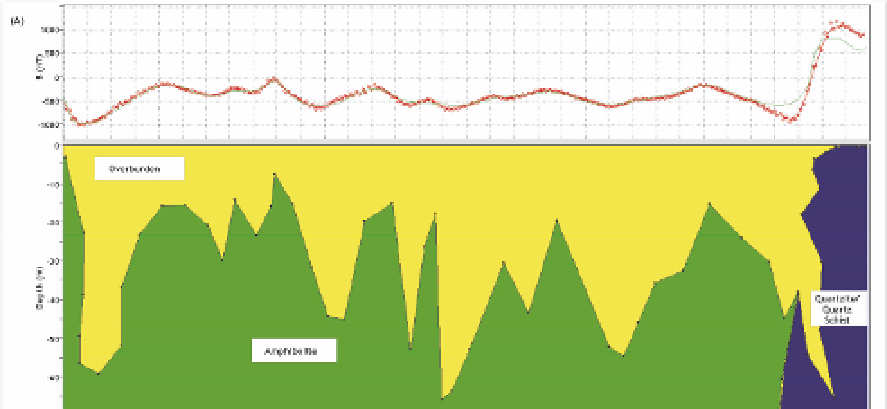Geoscience Reference
In-Depth Information
Figure 12A shows the observed and the calculated anomaly for the magneticprofile along
Itagunmodi to Aiyetoro and the corresponding geologic section in Figure 12B which is on
the southern part of the delineated area. Two model bodies are involved in the computation
and these include the Amphibolite (s = 280 SI unit), Quartzite/Quartz Schist (s = 400 SI unit)
together with the overburden (s= 10 SI unit). The contact between bodies represents
structural or lithological contacts. The model lithological contact when correlated with the
known geology shows a good correlation. Observed also are many fractures/faults in the
Amphibolite along the profile. The modeled basement blocks magnetic susceptibility
contrast ranges between 280 - 400 SI units.
Fig. 12. The observed and calculated magnetic profile along Itagunmodi to Aiyetoro
6. Discussion and conclusions
The geochemical data shows an anomaly with elemental association of Fe - Mn, Pb - Cr,
and Cd - Zn and trends approximately along the North - South direction. The VLF-EM data
revealed the existence of linear features which are interpreted as mineralized fractures,
faults and veins. These linear features are consistent across the study area and run
approximately in the N - S direction. These structures exist from near the surface to a depth
of up to 100m. The magnetic data also mapped the linear features, magnetized bodies
(interpreted as dykes) and the geological contacts. The coincidence of electromagnetic (VLF)
and magnetic anomalies and their correlation with the geochemical anomaly, especially on
the amphibolites, is an indication of the occurrence of sulphide deposits rich in Zn-Pb-
Cralong the identified linear features . The geophysical methods engaged have helped to
map the structural complexity such as evidence of faulting, mineralized fractures, joints and
dykes in the study area. In addition, it is now evident that mineralization is not limited to







Search WWH ::

Custom Search